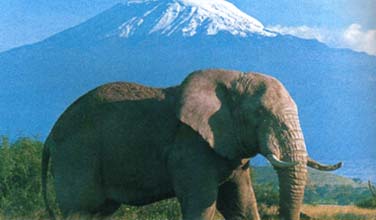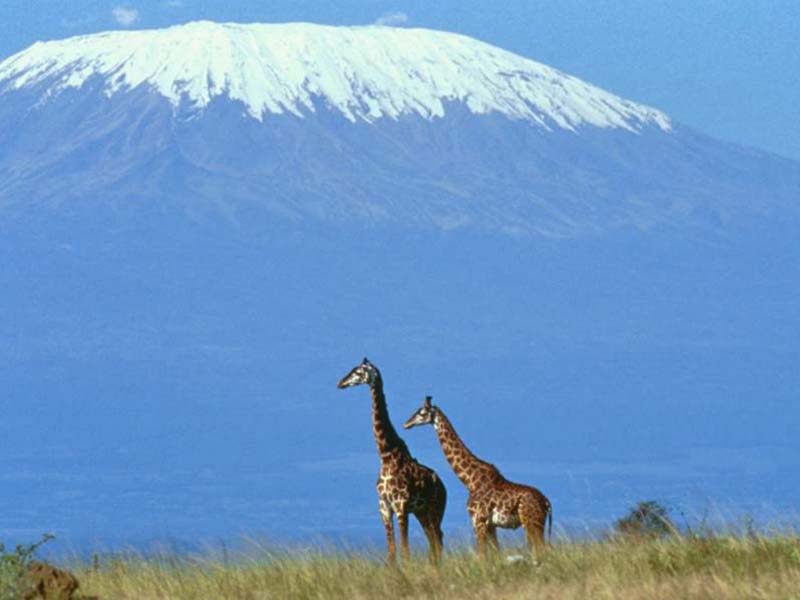|
TANZANIA SAFARIS -
Mount Kilimanjaro Climbing Safaris
Africa's highest
mountain, Mount Kilimanjaro stands on featureless part of the East
African plateau, on the Tanzanian side of the Kenya border near Moshi,
side by side with the smaller Mount Meru. These mountains are extinct
volcanoes, with Kilimanjaro actually being the agglomeration of three
distinct volcanoes, Kibo (5896m/ 19,340 ft), Mwenzi (5,149 / 16,896 ft)
and Shira (3,962m / 13,000 ft). whose violent creation is geologically
associated with the creation of the Great Rift Valley, 100km to the
West.
- The East African mountains have
created a micro-climate around themselves and the rain-shadow
created to their Southand East supplies the beautiful and superbly
fertile land in which the towns of Moshi and Arusha are situated,
full of banana groves and coffee plantations. Kilimanjaro National
Park comprises all of the mountain above the tree line and six
forest corridors that stretch through the forest belt.
Mount Kilimanjaro climbing, trekking, hiking in Tanzania
- Origin of the name 'Kilimanjaro', hence
Mount Kilimanjaro
There are many explanations for how the Mount Kilimanjaro got its
name and no one can agree what is the truth. "Mountain of
Greatness", Mountain of Whiteness", "Mountain of Caravans",
are all names derived from the Swahili and Chagga dialects.
From what we little know on the subject, it is thought it might have
something to do with the Swahili word 'kilima', which means 'top of
the hill'. There is also a claim that the word "kilemakyaro" exists
in the Chagga language, meaning "impossible journey". But the truth
is that no one really knows and is a good discussion point of where
the name Mount Kilimanjaro came from..
Mount Kilimanjaro History
In the second century AD, Ptolemy, the Greek astronomer and
cartographer, wrote of mysterious lands to the south of modern day
Somalia that contained "man-eating barbarians" and a "great snow
mountain". This knowledge he must have gained from the Phoenicians,
who had circumnavigated Africa by this date. Ptolemy's account
stands as the first documented reports of Africa's highest mountain,
Kilimanjaro.
The next thousand years, however, brings no mention of this great
African mountain - Kilimanjaro. As the coast of East Africa rose in
prominence as a trading route after the establishment of Arab rule
in the sixth century, the main hub of activity centered around the
island of Zanzibar and the immediate mainland known at the time as
Zinj. The Arabs had at their disposal, an almost unlimited supply of
ivory, gold rhinoceros horn and a far more lucrative and mobile
commodity, slaves. The great slave caravans that ventured far into
the interior would have passed close by to the mountain to collect
water from the permanent streams but it was the Chinese traders of
the twelfth century that were next to record observations of a great
mountain west of Zanzibar.
Kilimanjaro was to remain a mountain of myth and superstition
throughout the centuries - one of the great secrets of interior of
'the dark continent'. It was the desire to find the source of the
Nile that drove British explorers and geographers to first head
inland towards the mysterious mountain around 1840 onwards. Up until
then Kilimanjaro had been tall tale told by the Arab traders of
Zanzibar. No one really believed that there was a snow-capped
mountain on the equator.
On 16th October 1847, Rebmann a missionary, with the help of eight
tribesmen and Bwana Kheri, a caravan leader, set off for the
mountain of Kasigau, where they hoped to establish the first of
mission posts. The journey went well and they returned to Mombasa on
the 27th of the same month. Along the way they had heard the stories
of the great mountain "Kilimansharo", whose head was above the
clouds and "topped with silver", around whose feet lived the
mountain's people, the fearsome Jagga (now Chagga). Krapf
immediately sought permission from the governor of Mombasa for an
expedition to Jagga. His official reason was to find areas suitable
for mission stations, but the legendary mountain was becoming of
increasing interest to the two missionaries. Disregarding warnings
about the 'spirits of the mountain', on the 27th April 1848, Rebmann
and Bwana Kheri set off for Jagga and within just two weeks was
standing on the great steppe of East Africa within sight of
Kilimanjaro ... the first European to set eyes on the mountain.
There really were snowfields on the African equator. In April 1849,
Rebmann's observations were published in the Church Missionary
Intelligenciers and although not properly substantiated until twelve
years later, it remains the first confirmed report of Mount
Kilimanjaro.
- The first of
Mount Kilimanjaro ascent in 1889
In 1887, Professor Hans Meyer, a German geographer, made his first
attempt upon the summit of Kibo. Accompanied by Baron Von Eberstein,
Meyer was eventually defeated by a combination of thick snow, 30m
ice walls and his partner's altitude sickness.
After an aborted expedition in 1888,
Meyer returned the following year accompanied by the famous
Alpinist, Ludwig Purtscheller and a well organised support group
determined to scale the peak. The climbers came prepared with state of
the art equipment and established a base camp on the moorland from where
porters ferried fresh supplies of food from Marangu. Daunted by the
precipitous ice cliffs of the northern crater rim and the extensive ice
flows to the south, the two climbers agreed that the best chance of
success lay by tackling the less severe incline of the south eastern
slope of the Kilimanjaro mountain. From their advance camp at 4300m the
two climbers set off at 01.00hrs and reached the lower slopes of the
glacier at about 10.00hrs.
Although the glacier was not as steep or high as the walls encountered
on Meyer's previous attempt, its incline never went below 35 degrees and
ice steps had to be cut. Progress was slow but after 2 hours the men
reached the upper limits of the glacier where the incline decreased. A
further 2 hours of painful trekking through waist high snow and over
deep weathered ice grooves found the climbers at the rim of the crater
with the summit in sight. However time and strength were running out and
the summit was still another 150m above them, so they returned to
advance camp to try again after three days. This time the route was
clearly marked and the previously cut ice steps had held their shape.
The rim of the Mount Kilimanjaro was reached in 6 hours and at exactly
10.30hrs Meyer became the first recorded person to set foot on the
highest point in Africa.
Although Meyer and Purtscheller laid the
trail for further ascents on Kilimanjaro, there was not an instant queue
of would-be climbers. It wasn't until 1912, over 20 years later, when a
path from Marangu was established and the first huts at Mandera and
Horombo were built by Dr. E Forster for the newly formed German
Kilimanjaro Mountain Club, that activity began in earnest.
Mount Kilimanjaro was born of the
catastrophic movements in the Earth's crust that created the Great Rift
Valley that runs from the Red Sea through Tanzania to Southern Africa.
Around 25 million years ago East Africa was a huge flat plain that
buckled and ruptured after the African and Eurasian Continental Plates
rebounded off each other causing huge rifting and weak spots in the
thinning crust that led to the formation of many volcanoes in the
region. Where the original valley was deepest, the volcanic activity was
greatest eventually forming the huge volcanoes of Ngorongoro Crater on
the Rift itself and a string of volcanoes to the East including Meru,
Kenya and Kilimanjaro. Ecology Mount Kilimanjaro has five major zones
and the activity within each of these is controlled by the five factors
of altitude, rainfall, temperature, flora and fauna. Each zone occupies
an area approximately 1000m in altitude and is subject to a
corresponding decrease in rainfall, temperature and life from the forest
upwards.
Mount Kilimanjaro is a
perfectly shaped volcano still active rising
sheer from the plains. At 5895m it is the highest in Africa and is snow
capped. Mount Kilimanjaro can be climbed any time of the year but there
is usually a lot more rain during April, May and November. At the lower
levels, you will pass through cultivated farmlands rising through
tropical rain forest onto alpine meadows and finally the barren
landscape leading to the snow and ice capped summit. The lower levels
also offer the chance to view a wide variety of animals, birds and fauna
in their natural habitat.
There are five major
Mount Kilimanjaro Climbing routes through the forest
and moor land areas before joining the south circuit path between 3500m
and 4500m they are;
Kilimanjaro Machame route, Mount Kilimanjaro Marangu route, Kilimanjaro
Climbing Lemosho Route, Kilimanjaro Rongai Route and Climbing
Kilimanjaro Umbwe route.
From Mount Kilimanjaro
south circuit path various walking (trekking),
scrambling, and technical climbing trails take you the last
1200m or so to the summit. Most people however take
the final leg of the Kilimanjaro Marangu route
unless you are a technical climber in which case the summit may be
reached via Rebman glacier, decken glacier or heim glacier amongst
others. The final trekking Kilimanjaro ascent
to the summit starts normally at about 2.00 am from Kibo
hut so that it is reached before dawn to watch the sunrise and gaze out
over the vast expanses of African bush land from the roof of
Africa - Mount Kilimanjaro.
Mount Kilimanjaro
National Park is the area above 2,700 meters on the mountain.
Kilimanjaro National Park includes the moorland and highland zones,
Shira Plateau, Kibo and Mawenzi peaks. In addition, the Kilimanjaro Park
has six corridors or rights of way through the Kilimanjaro Forest
Reserve. The Forest Reserve, which is also a Game Reserve, was
established in 1921; the Park was established in 1973 and officially
opened in 1977.
Mount Kilimanjaro facts and figures
*The highest peak in Africa
*The highest freestanding peak in the world
*The highest 'walkable' mountain in the world
Kilimanjaro Protection
*1921 : forest reserve established
*1973 : park established
*Park HQ Opened : 1977 (by President Nyerere)
*Unesco World Heritage : 1989
Mount Kilimanjaro location
*Northern Tanzania : East Africa
*2 50' / 3 20'S : 37 00 / 37 35'E
Kilimanjaro areas
*Park : 756 sq km / 75,353ha
*Forest reserve : 929 sq km / 92,906ha
Mount Kilimanjaro altitudes
*Marangu Gate : 1,830m
Kilimanjaro Summit
: 5,895m -25C to 10C
Kilimanjaro rainfall at altitudes
*Forest Belt : 1800m : 2300mm
*Mandara Hut : 2740m : 1300mm
*Horobo Hut : 3718m: 525mm
*Kibo Hut : 4630m : 200mm
Kilimanjaro temperatures
*Generally falls 1C with every 200m increase in altitude
*Marangu Gate : 10C to 30C
-
Trekking Mount Kilimanjaro
climbing routes/Itineraries:
-
MKCTK
601: Kilimanjaro Trekking Marangu
Route

|
|
 |
|
Mount Kenya |
|
Mount Kilimanjaro |
Mount Kilimanjaro Facts, Mount Kilimanjaro Guides, Mount
Kilimanjaro Porters, Mount Kilimanjaro climbing Joining Dates, Mount
Kilimanjaro Climbing Gears, Mount Kilimanjaro Climbing Needs, Mount
Kilimanjaro climbing Itineraries. |
|

Mount Kilimanjaro
Climbing, Trekking, Hiking in Tanzania, Climbing
Mount Kilimanjaro, Trekking Africa's mountains,
marangu route, machame route, hike rongai route,
trekking lemosho route, walking umbwe route, uhuru
peak, snows of Kilimanjaro, Wildlife of Kilimanjaro
safari, Mount Kilimanjaro Facts, Mount Kilimanjaro
Guides, Mount Kilimanjaro Porters, Mount Kilimanjaro
climbing Joining Dates, Mount Kilimanjaro Climbing
Gears, Mount Kilimanjaro Climbing Needs, Mount
Kilimanjaro climbing Itineraries.
|